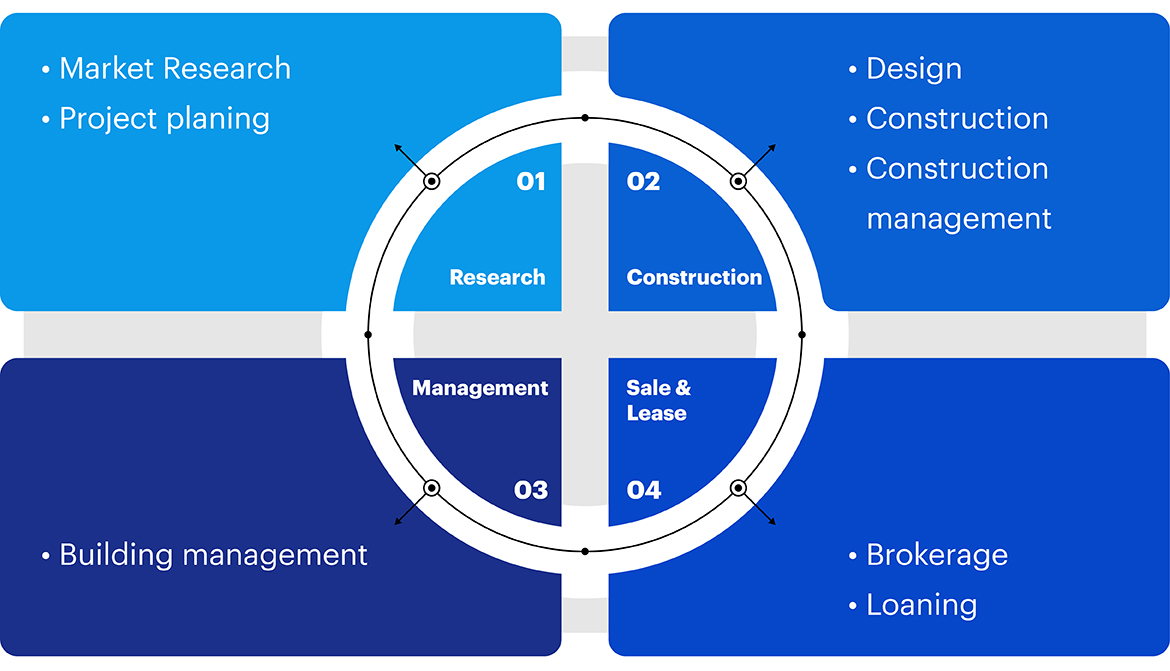Real estate has never been known as an industry that is willing to change. The essence of real estate products is very valuable and important, making investors afraid of risks during the transaction. In addition, consultants and brokers are also afraid to apply digital technology or trade on online platforms since it can directly affect their revenue.
According to recently KPMG’s statistics, about 95% of global businesses in terms of real estate have some responsibility for implementing innovation and digital transformation for businesses (1). Proptech’s real estate technology market is also flourishing with a market size reaching approximately 16 billion USD in 2018, compared to 10 years ago with 20 million USD (2). This change can be considered inevitable because it is undeniable that the demand for digital life of customers born in the Internet age as well as the ability of technology is increasing while the cost is more reasonable. Based on the report by Ericsson, it is estimated that by 2022, there will be around 8,9 billion mobile account registrations in the world, more than 3 times higher than in 2015 (3). At the same time, the cost of technology has likewise decreased rapidly, for instance, the cost of sensors in 2020 has been reduced by nearly 70% compared to 2014 while the quality has improved markedly.
How is digital technology unlocking the potential in the real estate industry?
Digital transformation in the life cycle of real estate products
The real estate product life cycle consists of 4 main stages: Research – Construction – Sale/Lease – Management.
At each stage, digital technology is unlocking new potentials and new values for real estate businesses and customers as well.

1. Research
The research phase aims to assess the current state of the region, development potential and suitability for the needs of the target customer. Each investor has their way of researching the market as well as sources to make decisions and plan the project accordingly. Digital technology has also been providing tools to accelerate and professionalize the research process through data analysis and evaluation.
ZoneSavvy is one of the platforms supporting investors during the Research phase. It evaluates all regions in the U.S. based on a range of indicators such as population density, median age and median income, existing businesses in the region, and the business types that are in great demand of the region. As a result, small businesses with limited resources and information can find and choose where to build their company and headquarters.
2. Construction
Construction is a traditional field, but the emergence of technology has brought a new wind by not only helping to optimize the cost and time of the construction process but also ensuring that process of construction is carried out safely, minimizing accidents thanks to the increasing application of IoT technology and big data analysis.
According to the U.S. Occupational Safety and Health Administration, the construction sector accounts for 21% of annual workplace deaths in the United States while construction workers make up only 6% of all workers (5). In order to solve this problem, electronics companies, Apple, for example, has adopted IoT technology and developed smart watches that enable the tracking of the wearer’s location, heart rate, temperature or fall warning in real-time, helping the location manager detect safety hazards and respond quickly. Many other wearables manufacturers such as SolePower, SmartCap,… it has also integrated incident detection functions such as falls, sickness, collisions,… and activated emergency signals into the special worker’s clothes such as boots, helmets, goggles. Meanwhile, a variety of machine systems today enable the transmission in terms of performance data and error notifications that simplify the upgrade and maintenance process and bring safety to users. Another example of IoT application in risk control is Proptech Pillar Technologies company which has developed sensor devices and data-processing that allow real-time risk warning and vertical analysis of location risk levels. The sensors detect temperature, humidity, dust particles, pressure, noise and vibration. This data is collated to provide a detailed understanding of the conditions of the place.
Besides ensuring safety during construction, technology is also contributing significantly to providing cheap and high-quality real estate products to the market with 3D printing technology. Winsun, a Chinese technology company, pioneered the construction of homes using 3D printing. Compared to traditional construction methods, Winsun has saved up to 80% of construction costs and 60% of personnel costs.
3. Sale and Lease
The demand for buying or renting a house from afar, especially due to the trend of buying foreign houses by high-income earners along with the impact of the gap caused by the Covid-19 epidemic. However, the sale and leasing process is often taken through brokers resulting in limited images, misinformation or unclear. These are huge risks for both the supplier and the buyer.
Virtual reality (VR) has emerged as a solution that allows customers to visit a house with simulated reality images easily from anywhere in the world. Real estate developers, hoteliers and other businesses are using this technology to give potential customers a sense of the product. Using real-time technology and devices, such as Samsung Gear VR headsets, real estate developers can showcase the progress of developing homes as well as completed ones. In Vietnam, many large real estate developers such as Sungroup and Vingroup also use the power of virtual reality to help potential buyers experience the space even before construction begins. Similarly, Floored, a New York-based real estate technology company, uses 3D camera technology to scan apartments, offices and homes to develop customizable 3D models. The platform allows users to create interactive environments, quickly evaluate space, test virtual furniture options, adjust lighting conditions and view space from all angles.
4. Management
The real estate management and operation phase is the most commonly applied stage of technology with more than 50% of real estate technology companies focusing on researching and developing solutions for this period (1). The reason could be because this is the period when operating managers work directly with customers for the longest and it is complicated to ensure that customers are satisfied throughout the time.
Operating a building optimal and efficient requires a stable interaction of data flow and a smart and flexible network. But in fact, traditional infrastructure often consists of countless legacy and proprietary systems and is not easy to share data, which makes it difficult to design these flexible systems, especially in existing buildings. Currently, many businesses have embarked on planning and providing flexible, robust and secure IT infrastructure to meet the needs and expectations of users in applying technology to management.
Imagine when you drive to the company, the building system automatically recognizes your car and directs you to the parking lot. When you sit in any position, the desk automatically adjusts to your favorite sitting position, the lighting, the temperature in the room is also adjusted accordingly. This is not a story from a distant future, this is the true story at The Edge building in Amsterdam. The University of British Columbia, Vancouver, has also used data analytics to help make important property decisions and mitigate risks in managing 333 buildings on campus. The university has built a detailed information system about every building including capacity, operations, seismic vulnerabilities and operating costs. As a result, the British Columbia School can determine the level of earthquake safety in each building and retrofit appropriate support equipment, while building an optimal mode of operation of each building, ensuring the continuity of campus activities.

Future’s perspective
The barriers of Digital Transformation with real estate businesses
We can see that today’s technology is incredibly powerful and mutable. However, this does not mean that all of the above technologies will be applied in a popular way shortly because the limited digital capacity and conservative culture of the real estate industry remains a barrier to the businesses.
Perhaps real estate businesses understand that digital technology is an inevitable step if they do not want to be left behind. But where to start? What will the structure be like in the business? How to collect and evaluate data effectively? How to ensure absolute security? These are still questions that not only Vietnamese real estate enterprises are wondering but also large enterprises in the world do not have appropriate answers.
What should a real estate business do?
It is impossible to figure out the answers to these questions immediately. First of all, real estate businesses need to define for themselves a clear digital transformation strategy, based on the business strategy. From there, businesses need to map out a roadmap to achieve that strategy, not only in terms of technology but also in terms of people, organizational culture as well as other changes in process and operation. Same as real estate, when it comes to digital transformation, don’t think about the present value, think about the future value it offers.
Reference sources:
(1) KPMG. 2019 Is your digital future in the right hands?
(2) Intelligent Building Europe. How Big is Proptech’s Market Size?
(3) Ericsson Mobility Report: 70 percent of world’s population using smartphones by 2020
(4) Theatlas. 2020 The average cost of IoT sensors is falling
(5) United States Department of Labor. Commonly Used Statistics, Federal OSHA coverage




